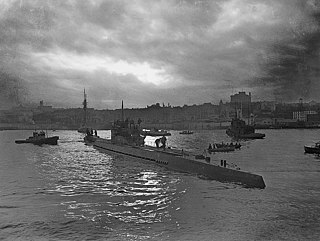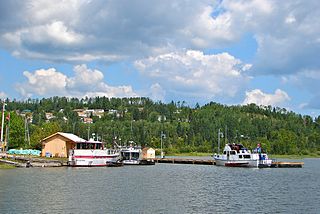This page is based on this
Wikipedia article Text is available under the
CC BY-SA 4.0 license; additional terms may apply.
Images, videos and audio are available under their respective licenses.
Quebec is a French speaking province in Eastern Canada.

The River class was a class of 151 frigates launched between 1941 and 1944 for use as anti-submarine convoy escorts in the North Atlantic. The majority served with the Royal Navy (RN) and Royal Canadian Navy (RCN), with some serving in the other Allied navies: the Royal Australian Navy (RAN), the Free French Navy (FFN), the Royal Netherlands Navy and, post-war, the South African Navy (SAN).
Marine Industries Limited (MIL) was a Canadian ship building and rail car manufacturing company, in Sorel-Tracy, Quebec, with a shipyard located on the Richelieu river about 1 km from the St. Lawrence River. It employed up to 10,000 people during the post World War II boom.

The Battle of the St. Lawrence involved marine and anti-submarine actions throughout the lower St. Lawrence River and the entire Gulf of Saint Lawrence, Strait of Belle Isle, Anticosti Island and Cabot Strait from May–October 1942, September 1943, and again in October–November 1944. During this time, German U-boats sank several merchant ships and four Canadian warships. There were several near shore actions involving the drop of German spies, or the attempted pick up of escaping prisoners of war. Despite the 23 ships lost, this battle marked a strategic victory for Canadian forces as ultimately they managed to disrupt U-boat activity, protect Canadian and Allied convoys, and intercept all attempted shore operations. This marked the first time that a foreign power had inflicted casualties in Canadian inland waters since the US incursions in the War of 1812.

HMCS Bras d'Or was a hydrofoil that served in the Canadian Forces from 1968 to 1971. During sea trials in 1969, the vessel exceeded 63 knots, making her the fastest unarmed warship in the world at the time.
HMCS Prevost is a Naval Reserve unit commissioned Her Majesty's Canadian Ship, of the Canadian Forces Naval Reserve based in London, Ontario.

HMCS Kokanee was a River-class frigate that served in the Royal Canadian Navy during the Second World War. She saw action primarily in the Battle of the Atlantic as a convoy escort. After the war she was sold to India and converted into a pilot vessel.

The Annapolis-class destroyer escort was a two-ship class of destroyer escorts that saw service with the Royal Canadian Navy and Canadian Forces from the 1960s to the 1990s. The final version of the St. Laurent-class design, the class was used extensively for anti-submarine warfare purposes. Both ships were sunk as artificial reefs after being retired, one on each coast of Canada.

HMCS Charlottetown was a River-class frigate that served with the Royal Canadian Navy (RCN) during the Second World War. She was the second vessel of the name, HMCS Charlottetown having been a Flower-class corvette that had been sunk earlier in the war. They are unique for being the only two ships to have shared the same pennant number, K 244. She was named for Charlottetown, Prince Edward Island.
Nipigon is an impact crater on Mars, located in the Arcadia quadrangle just North-East of the volcano Uranius Patera. It measures 9.3 kilometers (5.8 mi) in diameter.

HMCS Chebogue was a River-class frigate that served with the Royal Canadian Navy during the Second World War. She served primarily as an ocean convoy escort in the Battle of the Atlantic. She was named for Chebogue, Nova Scotia. During the war she was torpedoed and declared a constructive loss.

HMCS Kirkland Lake was a River-class frigate that served with the Royal Canadian Navy during the Second World War. She served primarily as a convoy escort in the Battle of the Atlantic. She was named for Kirkland Lake, Ontario.

HMCS Hunter is a Royal Canadian Navy Reserve Division (NRD) located in Windsor, Ontario. Dubbed a stone frigate, HMCS Hunter is a land-based naval establishment for part-time sailors as well as a local recruitment centre for the Canadian Naval Reserve. It is one of 42 naval reserve divisions located in major cities across Canada.










